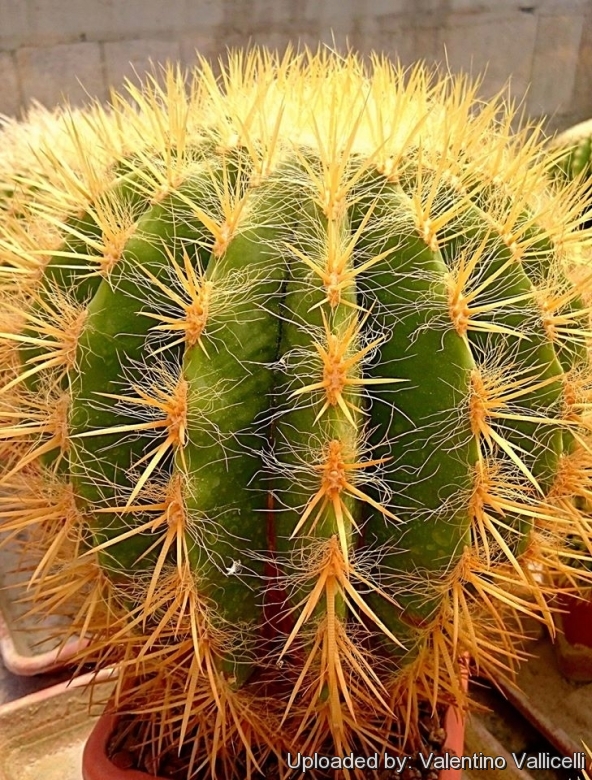Accepted Scientific Name: Ferocactus pilosus (Galeotti ex Salm-Dyck) Werderm.
Repert. Spec. Nov. Regni Veg. Sonderbeih. C t. 72. 1933

Ferocactus piliferus f. flavispinus Photo by: Valentino Vallicelli
Also known as Ferocactus stainesii var. pilosus (Yellow form) Coll. P. Massafra.
Origin and Habitat: Garden origin.
Synonyms:
See all synonyms of Ferocactus pilosus
back
Accepted name in llifle Database:Ferocactus pilosus (Galeotti ex Salm-Dyck) Werderm.Repert. Spec. Nov. Regni Veg. Sonderbeih. C t. 72. 1933Synonymy: 18
back
Common Names include:
ENGLISH: Yellow Fire Barrel
Description: Ferocactus piliferusSN|13424]]SN|13432]] f. flavispinus is a simple or clumping barrel/column cactus distinguished from the typical Ferocactus pilosusSN|13432]]SN|13424]] for its bright yellow (not red) spine clusters, all the other characteristics are identical, namely size and form of stems, spines, and flowers. It also grows more slowly than the type.
Cultivation and Propagation: Ferocactus piliferusSN|13432]]SN|13432]] f. flavispinus is one of the more rare ferocacti in cultivation, but resistant to cultivation. The only things that can kill this plant are cold and overwatering. Nevertheless, it is appropriate to provide adequate growing conditions in order to obtain compact plant with dense spine cove.
Growth rate: Slow growing to start but does well under cultivation. They need to be moderately large (about 20 cm in diameter) before they flower.
Soils: Use a an open and free draining mineral compost with little organic matter (peat, humus) that allows therefore roots to breath (as it is rot prone).
Repotting: Repotting every 2-3 years.
Watering: It likes a winter's rest and should be kept completely dry during the winter months. From early spring onwards the plant will begin to grow and watering should be increased gradually until late spring when the plant should be in full growth. Water regularly during the aestival growth cycle so long as the plant pot is allowed to drain and not sit in a tray of water (this plant need plenty of water) But needs to be avoided wetting the bodies of these plants while they are in sunlight. A wet cactus in the sun light can cause sun burning which can lead to scars or even fungal infections and death. From late summer watering should be reduced to force the plant to go in to a state of semi dormancy, by autumn you should be back in to the winter watering regime. Keep dry with ample airflow in winter (but for outdoors cultivation it is somewhat resistant to wet conditions, too if grown in very draining subtrata). In the rest period no high atmospheric humidity!! Care must be taken with watering as they tends to become swollen and untidy in growth habit if given too much water and shade.
Fertilization: Feed with a high potassium fertilizer in summer.
Hardiness: Keep dry at 5- 10° C in winter, but can tolerate sporadic light frost if kept on the dry side prior to, and during, cold weather.
Exposition: The plant tolerates very bright situations, if kept too dark they may become overly lush and greener and could be prone to rotting due to over watering. Strong light encourages flowering and heavy wool and spine production, but is likely to suffer from sun scorch or stunted growth if over exposed to direct sunlight during the hottest part of the day in summer. .
Uses: It is an excellent plant for container growing. But it is a very appreciated accent used to adds character to monotonous surroundings with little effort.
Edible uses: Floral buds are collected for human consumption. The Mexicans eat it's flowers as a dessert fried with the frying pan with sugar.
Pests & diseases: It may be attractive to a variety of insects, but plants in good condition should be nearly pest-free, particularly if they are grown in a mineral potting-mix, with good exposure and ventilation. Nonetheless, there are several pests to watch for:
- Red spiders: Red spiders may be effectively rubbed up by watering the plants from above.
- Mealy bugs: Mealy bugs occasionally develop aerial into the new growth among the wool with disfiguring results, but the worst types develop underground on the roots and are invisible except by their effects.
- Scales: Scales are rarely a problem.
- Rot: This species is particularly easy and accommodating, seldom suffer of cryptogamic diseases. Rot it is only a minor problem with cacti if the plants are watered and “aired” correctly. If they are not, fungicides won't help all that much.
Propagation: Seeds are the only way of reproducing. Seeds (no dormancy requirement) germinate in 7-14 days at 21-27° C in spring), remove gradually the glass cover as soon the plants will be well rooted (ca 1-2 weeks) and keep ventilated, no full sun for young plants! The seedlings should not be disturbed until they are well rooted, after which they can be planted separately in small pots.










